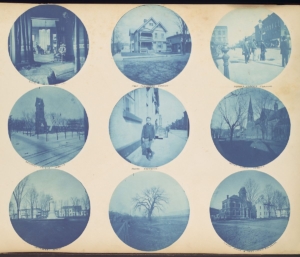
An Amateur Kodak Snapshot Album, 1890-1892
The street photographer is thought to be the evolution of the flaneur — literally a “stroller” or “loafer.”
A flaneur is an observer. He is a “connoisseur of the street,” a spectator roaming the city to experience life as it unfolds before him.
And what better way to capture these experiences than with a camera?
But just as every person-shaped blur in half of the street photos on Instagram, the identity of street photography is almost impossible to define.
At best, we can only hope to arrive at a general area of definition where most photographers could agree with.
Street photography captures “scenes” within a public space. If it is open to the public, and you of course can enter and leave as you wish, then it is a prime spot for street photography.
In this sense, we see the overlap between documentary photography (think photojournalism) and street photography. The difference, however, is that the documentary photographer already has an end goal for his photos (expose the horrors of war, for example). The street photographer is only curious about his immediate surroundings — his photos have no real social purpose rather than capturing human moments that interest him.
The Rise of Portable Cameras
In A Brief History of Portrait Photography, I’ve touched on the technological advancements that have improved exposure times from 15 minutes to almost instantaneous captures.
One of the by-products of these technical breakthroughs is George Eastman’s introduction of the Kodak. The Kodak camera was a relatively affordable, small handheld camera which came pre-loaded with a 100-exposure roll of film that produced circular 2.5-inch photos.
As the camera is now finally freed from the tripod, shooting photos in public places has become a reality.
The Father of Street Photography
It is generally accepted that Eugene Atget, while certainly not the first “street photographer” (to be fair, the title wasn’t very popular at the time especially for street photographers themselves), is the one who laid the foundations to the great monument that we’ll later come to know as street photography.
Atget’s work documented the streets of Paris from 1890 to the 1920s. You see, Paris as Atget knew it was to be demolished and rebuilt. So he lugged his large-format camera around the city and took pictures.
He didn’t have any higher, divine social purpose to take photos of the streets — the man just wanted to keep a record of places close to his heart before they vanished.
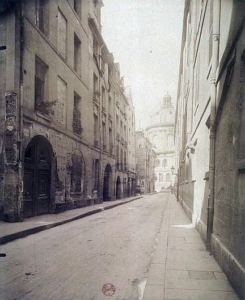
Rue Mazarine by Eugene Atget 1902
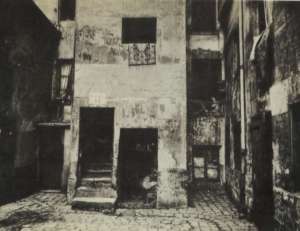
Cour 41, Rue Broca, Paris, France by Eugene Atget
The Decisive Moment
While Atget’s work didn’t give too much attention to the human element at the genre’s conception, Henri Cartier-Bresson was one of the first photographers to shine the spotlight to the man on the street.
Cartier-Bresson, an icon to street photographers of the world over, suggests that there is a split second where every element of a scene falls into place, with the resulting image communicating the captured event with perfect clarity.
In his book, aptly titled The Decisive Moment (1952), Cartier-Bresson likens capturing the decisive moment to hunting, “I prowled the streets … ready to pounce, determined to ‘trap’ life.”
His weapon of choice, the mighty (and stealthy) Leica M3 with a standard 50mm lens, allowed Cartier-Bresson to “fade into the background,” patiently waiting for the decisive moment before trapping it forever on a roll of film, without alerting a soul.
These split seconds are what Cartier-Bresson coined as The Decisive Moment, a concept that has survived well into the 21st century.
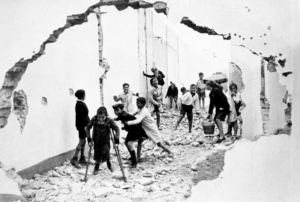
Children in Seville, Spain, photograph by Henri Cartier-Bresson, 1933.
Of course, Bresson’s stealthy observer approach to the genre is not the only prevailing influence amongst the street photography community.
Robert Frank’s The Americans (1958) is easily one of the greatest photo books published on the subject matter. In his book, Frank highlighted an outsider’s (often critical) perspective of the not-so-sunshines and rainbow side of American society.
His photos did not shy away from showcasing racism, mass consumerism and poverty — quite possibly fathering the brand of gritty, visceral and sometimes dark imagery in street photography of today.
In Robert Frank’s work, the street photographer is no longer just an observer, but also a commentator.
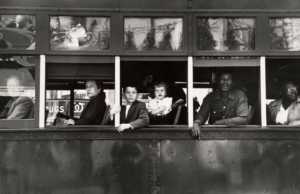
Trolly – New Orleans, 1955. From The Americans © Robert Frank
Street photography is indeed a tough genre to nail down. But we do know it has matured and grown in popularity more than ever, thanks to the digital age.
For the purist seeking to understand what exactly is street photography, and what type of imagery he should pursue, Eric Kim explains it best: “I think that in this sense street photography is a lot like rock music. There are a billion types of sub-genres of ‘rock’ music – and each of these sub-genres say that they are the ‘true’ rock music– and that the rest of them are either phonies, fakes, or posers.”
